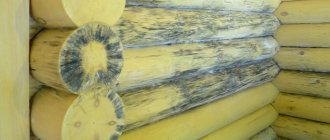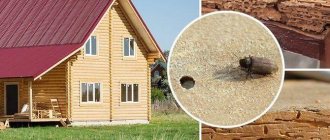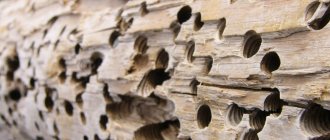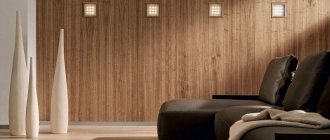To get rid of dampness, you need to carry out a number of preparatory measures. Understand why it appeared, where the moisture is coming from and how you can fix it. You will learn about all this from our article.
Dampness is a very unpleasant phenomenon that can destroy stored crops. If moisture “settles” in the room, this can lead to destruction of the structure and deterioration in the health of everyone who regularly goes down to the cellar or basement. Read about why dampness “comes to visit” and how to get rid of it as quickly as possible in our material.
Dampness in the house - causes
Condensation forms on ceilings, floors and walls for a number of reasons. The most common causes of dampness are the following factors.
- Ventilation problems . Errors at the design or construction stage lead to poor ventilation in the room. The most common mistake is the following: poorly laid floor slabs and construction debris block the ventilation ducts. When there is a difference in temperature inside and outside the room, condensation forms on the windows and walls, and this is the first sign that mold will soon appear.
- Increasing groundwater levels . In spring and autumn, when basements and cellars begin to flood due to heavy rains, dampness also increases. Poor drainage causes water to accumulate in underground storage areas, the humidity level rises sharply, and the room turns into a permanently damp closed system.
- Capillary penetration of moisture from the soil or through cracks . If the foundation was built in violation of the technology, then after some time due to temperature changes droplets of moisture will appear on its internal walls. Over time, this can lead to partial damage to the walls and even their collapse.
Ventilation
Sometimes, when determining why it is damp in the basement, you may not understand for a long time, as a result of which moisture penetrates into the room. Let's figure out how to get rid of dampness in the basement due to poor ventilation. After all, this can also lead to bad consequences.
Internal ventilation required:
- It should have a supply and exhaust system. The simplest scheme: two pipes, one of which comes almost from the basement floor, going outside under the ceiling, and the second is located directly under the ceiling and also leads outside.
- All of the outer parts of these pipes must be reliably protected from the possibility of rain and melt water.
Read on: Basement ventilation: consider, choose and do
How to get rid of dampness
First of all, all summer residents are concerned with the question of how to remove dampness. There are several reliable ways to eliminate dampness in the cellar and basement, but first you need to find out what caused the excess moisture. To do this, carefully inspect the room:
- if droplets of water appear on the walls and ceiling , the reason is due to poor ventilation;
- puddles on the floor indicate rising groundwater levels;
- droplets only on the walls hint at the lack of basement waterproofing.
Now let's look in more detail at ways to eliminate each of the reasons.
How to improve ventilation
If air exchange in a room is poor, the easiest way to improve it is by organizing additional ventilation. There are two types of basement ventilation:
- natural - involves the use of the so-called. vents - openings around the perimeter of the building. Their total area should be about 1/400 of the total area of the building;
- forced - involves the use of special equipment that pumps in fresh air. Typically used in large rooms.
To get rid of condensation on the ceiling and walls, you can carry out the following procedures:
- Thermal insulation of utility networks . If you have communications laid in the basement - water and sewer pipes - then the temperature of the water in them is always higher than the temperature in the room. As a result, condensation forms on them. To get rid of heat loss, you need to use a protective shell made of mineral wool, polystyrene foam and extruded polystyrene foam.
- Hood organization . For additional ventilation of the room, ventilation ducts or pipes are installed. Usually they are attached to vertical load-bearing elements or attached to existing structures. Two pipes are installed in the room - exhaust and supply, placing them at different heights from the floor in opposite corners of the room. This is necessary so that draft appears and the room is ventilated.
Declining groundwater level
Only qualified specialists can carry out the entire range of work on groundwater drainage.
If groundwater penetrates into a room, this is a serious problem, which over time can lead to partial collapse of the building. In this case, it is necessary to carry out a number of additional measures aimed at strengthening the foundation and pumping out groundwater. In particular, you will need to do the following:
- dig out the foundation;
- organize drainage around the perimeter of the building;
- strengthen the foundation;
- arrange external and internal waterproofing;
- make a blind area around the perimeter of the building;
- dry the room.
How to get rid of capillary moisture
With capillary penetration, moisture from the floor evaporates and settles on the walls
If moisture forms on the walls of a building, this means that it penetrates from the external environment, namely from the soil. You can prevent moisture from entering the room using some of the most popular measures:
- the use of waterproofing materials - primarily roofing felt, linochrome and waterproofing. All of them are made from pieces of dense material impregnated with bitumen. The cellar or basement is covered both from the outside and from the inside;
- protective compounds that clog pores in concrete are also considered an excellent “cure” for capillary moisture. Thanks to these compositions, it is possible to organize both a targeted effect on the holes through which moisture oozes, and application to all problem areas;
- bitumen mastic and polymer resins are used to additionally protect walls and floors from condensation. These compounds can be applied independently, but they do not always provide the necessary level of protection and it is better to supplement them with waterproofing materials;
- shielding is used in particularly difficult cases when, simultaneously with capillary action, groundwater appears in the room. Protective shields are made of geotextile, bentonite or clay.
Let's look at some of the described recommendations in more detail.
Necessary underground maintenance
In autumn, it is recommended to replace wooden grilles with metal ones. This is necessary to protect the basement from rodents. You can make the grill yourself using metal scissors.
In spring, all the problems are associated with floods. Melt water can easily flood the basement if no measures are taken. It is necessary to regularly clear the surrounding area of melted snow. Also, precipitation should not accumulate on the roof.
When working on the roof, you must follow safety precautions. It is better to use a method that will allow you to clean the roof without going upstairs.
The outflow of melt water must be provided for in advance. For this purpose, a storm drainage system will be installed. With the help of simple rules you can protect the subfloor of your house from destruction.
The reasons for collecting water underground usually lie in violation of the rules for its arrangement. It is important to properly insulate the basement, arrange waterproofing and ventilation. It is best to do this during the construction phase of the house. But if moisture has already penetrated into the basement, then you will have to learn how to dry the underground in a wooden house and eliminate all the problems.
External waterproofing of a basement or cellar
Inspect the structure and check the condition of the slopes, drainpipes, drainage system and blind area. If you basically do not have a drainage system, then first start by installing drainpipes and slopes. Next, move on to protecting the external walls:
- remove the old blind area;
- dig a hole about 50 cm wide from the outer wall of the basement;
- dry the outer wall;
- apply an antifungal composition to it;
- coat the wall with bitumen mastic, clay or concrete with liquid glass additives;
- make a blind area from a sheet of roofing material - secure it 0.5 m above the ground level and extend it beyond the edges of the outer wall of the basement;
- fill the hole.
Valuable advice
You can do everything yourself. You just have to put in the effort. Before using chemical compounds, you must first study the instructions for the drug. After all, it can be quite harmful.
Let's look at some points of this work:
- If the building is quite old, and from time to time gaps still appear in the basement (between the bricks or in the corners), it is possible, as a temporary measure, to plug them with rags coated with bitumen mastic and plaster them on top.
- It is necessary to organize a pit in the basement where water needs to be pumped out. We are talking about a waterproof “glass” made of metal, concrete with waterproofing or other similar material. The water will have to be pumped out of it.
- The floor should be inclined, albeit slightly, directed towards one corner. In this corner there is a pit. So, all the water will begin to collect exactly where it will be possible to easily fight it.
Floor work to eliminate dampness
If moisture penetrates the walls, hits the floor and evaporates, you should also address the flooring. The floor and walls should be concreted using liquid glass and roofing felt. You can also follow a simple algorithm (if you have a clay floor):
- remove a layer of clay about 5 cm thick;
- level the floor surface and cover it with two layers of waterproofing film;
- sprinkle it with clay on top or fill it with concrete and level the surface.
In case of seasonal flooding of the area, use another method:
- Place a layer of sand or gravel about 10 cm thick on the floor to protect against groundwater flooding. Add more gravel if necessary if groundwater seeps through the drainage layer;
- Apply special waterproofing plaster to the walls;
- Place glass jars with calcium chloride in the corners of the cellar (it will absorb excess moisture). For one cellar no more than 0.5-1 kg of powder is required;
- Sprinkle the floor with quicklime in a 1 cm layer - it will absorb excess moisture and dry the room. To combat fungus and mold, you can slak the lime directly in the basement. Pour some lime into an empty container and fill it with water. The released vapors will destroy germs and mold.
During the release of lime vapors, it is better to leave the room. Return there in an hour and immediately organize ventilation for several hours.
Alternative drying options
Depending on the type of room under which the basement is located, various difficulties arise with drying. In the case of a garage, any options are suitable, including not the cleanest ones, such as drying using hot coals. But, if the basement is located under the living rooms, then care and attention must be exercised - the foundation cannot be broken, there are obstacles to laying pipes in the form of ceilings and walls. It is best to install a ventilation pipe through a hatch or, as an option, consider ways to collect moisture directly in the underground. To do this, hygroscopic materials are placed below:
- Dry sawdust or shavings. This method cannot completely eliminate excess moisture. But, regularly replacing the material with fresh sawdust or shavings eliminates condensation from the room, which is also important for preserving the basement.
- Cardboard boxes can act as a substitute for sawdust and shavings, as they absorb water well. If you put in a sufficient amount overnight, then in the morning the spreading residues are removed, along with the reduction of condensation. With regular replacement, just like with sawdust, condensation will disappear.
- Slaked lime is used for whitewashing premises, but this material also absorbs moisture well. To reduce humidity in the underground, lime is poured along the walls and on the shelves. The moisture in the room will be absorbed, and the lime fumes will destroy the fungus.
- Calcium chloride, like lime, is dangerous due to its own fumes, but it collects water well - 1 kg absorbs up to 1.5 liters of moisture. The substance is lowered into the basement and left for 24 hours. If the calcium is dried by calcination, the material is again suitable for use.
When the listed options are not available or do not help, you can turn your attention to modern technology - household air dehumidifiers are on sale. Their main purpose is to dry rooms with swimming pools, but for a basement such a large capacity is not needed - mid-level models cost about 20-30 thousand Russian rubles. rub. and are connected to a 220 V network.
Attention! After switching on, the device collects moisture from the air into a suitable container - it must be cleaned regularly.
Traditional methods of dealing with dampness
You can normalize the humidity level in the cellar using folk remedies:
- dry the cellar walls using clay bricks. Place 2-3 bricks heated over a fire in different corners of the basement. As they cool, they will begin to absorb moisture. To achieve maximum effect, heating the bricks can be done repeatedly;
- to get rid of mold, treat the walls of the cellar with acetic or boric acid (dilute 20 ml of acid in 1 liter of water), you can use citric acid (dissolve 100 g of powder in 1 liter of water);
- remove all food stored there from the basement or cellar and treat the damp walls with diesel fuel, and then whitewash them.
Removing dampness and mold is a rather labor-intensive process. Therefore, you need to take care of organizing drainage and waterproofing in advance, then you won’t have to deal with high humidity. What methods of dealing with dampness do you know?
Additional measures
But what if the moment of construction was missed, and the waterproofing of the subfloor in an old wooden house was not carried out?
Here we will have to deal with the consequences of flooding. First of all, you need to wait until the groundwater drops and thoroughly dry the subfloor. To do this, you can use electric fans or air conditioners. Then the soil is leveled and waterproof material is laid on it as a continuous sheet. The best choice for these purposes is thick polyethylene film, which is carefully fixed to the ground. The film will prevent moisture from rising and seeping through, which will reduce the humidity level in the underground. However, it is worth remembering that this method is used only as a last resort. And for high-quality waterproofing it is better to use the methods described above.
Specialized devices
Today you can find many chemical anti-mold products on sale (some even use chlorine). However, using them in places where food is stored that cannot be removed during processing is simply dangerous. The best way to solve the problem is to use a dehumidifier. Today you can find several options for such units on sale:
- Simple. In this case, we are talking about a container and a lid into which a “tablet” is installed, consisting of pressed salt and other components that are adsorbents. The salt is saturated with moisture and gradually melts, after which the tablet changes. Usually one piece is enough for 2-3 weeks. The device itself costs about 600 rubles, and 2 tablets will cost about 400 for 1-3 months. This is the cheapest option. In addition, the device does not require connection to electricity.
- Specialized. In this case, we are already talking about a large device powered by electricity. The cost of such units is from 15,00 rubles, but their productivity is much higher. In addition, such dehumidifiers are usually equipped with additional functions. They trap the pores of mold and mildew and eliminate unpleasant odors. There are models with ionization function.
Some carry out quartzing. This will require an ultraviolet lamp. This does not have much effect on humidity, but disinfection is carried out, which can be done in more accessible ways.
How to get rid of condensation in the cellar
Condensation can be removed in many ways. In some cases, one small action helps, in others you have to sweat.
Each type of storage has its own temperature. What temperature should be in the cellar with vegetables? The norm is considered to be no lower than 0 °C. Approximate humidity – 70-95%. It is important to maintain the necessary indicators in the cellar.
The following will help in the fight against condensation: internal and external waterproofing, vapor barrier, exhaust hood, ceiling insulation.










